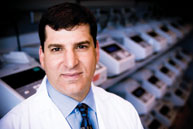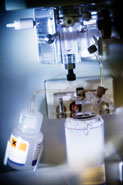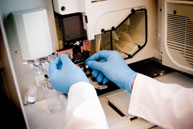Personalized prescriptions
Tailoring drugs to genes will do away with patient as guinea pig

Michael Phillips believes that the medical system could undergo radical changes in the next five years
Biochemist Michael Phillips has seen the future of medicine, and it's cheaper, more effective, and a lot less painful. In his vision patients will walk into a doctor's office to have a trickle of blood sampled and run through a computer, which will tell them what drugs they need and in what dosage.
No risk of overdoses or unwanted side effects. Prescriptions will be as individual as fingerprints.
"I think we can have this in five years," Phillips says. "If that long."
Phillips leads the Genome Quebec and Montreal Heart Institute Pharmacogenomics Centre, whose mission is to do away with the "one size fits all" approach to prescriptions. Its main tenet: each person metabolizes drugs differently, so prescribing the same drug at the same dosage to everyone borders on barbaric.
"But that's how most doctors work today," Phillips says. "They've been prescribing to a black box and we've been guinea pigs to some extent. This has to stop."
The danger is that homogeneous prescriptions can trigger adverse drug reactions, one of the leading causes of hospitalization.
Phillips holds up a bar graph shaped in the standard bell curve. "Most people metabolize drugs at this rate," Phillips says, pointing to the bulk of the bell. His finger slides over to the far right where the curve tapers off in a small hump. "But you have poor metabolizers too, which make up five to 10 percent of the population."

The McGill University and Genome Quebec Innovation Centre boasts a wide array of cutting-edge equipment including an illumina bead array genotyping system (Top), a DNA capillary sequencer (Below Left) and a bank of ABI PCR machies (Below Right)
Photos by Claudio Calligaris
These people's bodies don't break down the drugs fast enough, Phillip explains. So the drugs build up in their blood faster than they are excreted. If the drugs reach toxic levels, severe illness, even death, can result.
Blame it on a group of enzymes called cytochrome P450 (designated CYP P450s), one of the prime targets of pharmacogenomics. These proteins found in liver cells are responsible for breaking down several classes of toxins and drugs. One such protein, CYP 2D6, has more than 60 known variations, each with their own metabolic activity.


But not every human is made the same, and each person has a different combination of genes resulting in unique responses to drugs.
Take the CYP 2C9, which metabolizes warfarin, a commonly used blood thinner. A weak or poorly functioning CYP 2C9 results in excessive blood levels of the drug, which in turn inhibits blood clotting. This can lead to heavy internal bleeding.
"So doctors have to prescribe a low dosage and slowly boost it as needed," Phillips says.
"A patient has to come back every other day for blood tests. And with our health system being the way it is, they have to wait forever for a 15 minute test."
Pharmacogenomics is still at its infancy, Phillips says, but it's not for lack of technology. He just needs the resources. "We're playing catch up," he says. "If we had the means to do it, we could."
From his tiny seventh-floor office in the McGill University and Genome Quebec Innovation Centre, Phillips takes all the promising research on paper and turns it into clinical reality. Thirty paces away, grad students in lab coats pipette genetic materials into sequencing and genotyping machines, dozens upon dozens in rows.
"Few places in the world have as many of these machines as we do," he boasts.
The labs at the Innovation Centre are run by Genome Quebec, a private, non-profit consortium that finances genetic research and provides access to the facilities for a fee.
Those labs are but a conduit for Phillips' pet project, a cutting-edge genotyping lab complex in the Montreal Heart Institute that, when completed in about 18 months, will be the first of its kind. In one completely isolated lab, a patient's DNA will be extracted and prepared for polymerase chain reaction (PCR), a process that makes millions of copies of DNA.
The sample is then placed in what Phillips calls a milk door, a small airtight chamber between two labs where the air is sucked out and sterilized before the sample can reach the next phase.
This is what Phillips calls Good Laboratory Practice, or GLP. "It ensures a constant environment with no contaminants whatsoever," he says.
After the PCR, the sample is prepared for genotyping and passed through another milk door to a third lab, where the patient's genetic profile, or genotype, is finally determined.
"We're really at the ideal place for this kind of research," Phillips says about Quebec. Geneticists already have an interest in the Lac St. Jean-area population, where large families descended from a founder population provide a unique resource for the understanding of complex diseases. Montreal is also host to a myriad of cutting edge pharmaceutical companies, such as Merck, Pfizer, Novartis and Abbott Laboratories.
"And with Canada's socialized medicine, the government is our main target as a client.
They want to see health care costs go down," he adds. Only a fraction of the money saved by reducing adverse drug reactions, Phillips contends, would be required to go into the cost of genotyping tests.
But to save money, the government must first give money, as they did last month. Phillips was one of 33 scientists who won massive funding for genomics research. The $18.4 million over four years awarded by Genome Canada, the federal genomics funding body, will study the efficacy of drugs for cardiovascular diseases. Phillips and his team will investigate the toxicity of drugs for congestive heart failure, hypertension and stroke in different people and develop guidelines for ethical pharmocogenomic treatment.
Though pharmacogenomics is about getting the right drug to the right person, it doesn't envisage tailor-made drugs for the minority who metabolize poorly. Such people need to find alternative treatments or to wait for pharmaceuticals to develop special variations for them. Since the industry uses pharmacogenomic tests to target drugs for the largest number of clients, custom-made drugs are not on the development horizon.
But anticipating adverse reaction is itself of great benefit. "There is no point treating patients with chemotherapy drugs that make them sicker with no benefit if we have the know-how and the technology to prevent it," explains Phillips.
Phillips knows his biggest task will be enlisting the copious stakeholders in a complex and bureaucratic health system: doctors, patients, insurers, researchers, decision-makers, and ultimately the public.
As far as he's concerned, it's but a minor obstacle against the heavy momentum already built here.
"People are looking at pharmacogenomics, they see there's a horse race going on, and they're coming into the stalls," Phillips says. "But we're already on the second lap."

